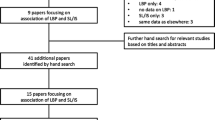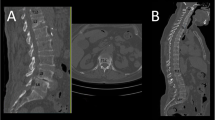Abstract
Study Design
Retrospective cross-sectional study.
Objectives
To describe lumbar spondylolysis and spondylolisthesis and establish their prevalence in individuals with Down syndrome.
Summary of Background Data
Orthopedic problems in Down syndrome are variable and numerous. Lumbar spondylolysis and spondylolisthesis may be common conditions in Down syndrome. However, there has been a paucity of data on the association of these conditions in the published literature.
Methods
A retrospective review of 110 patients with Down syndrome seen at a single institution from 2000 through 2012 was performed. Medical records, X-rays, and physician dictations were carefully reviewed to establish a detailed database of the study population.
_
Results: Of the 110 patients in the study, 20 exhibited spondylolysis (unilateral, n = 11; bilateral, n = 9), whereas 38 had lumbar spondylolisthesis (isthmic, n = 9; dysplastic, n = 2; degenerative, n = 27). No gender difference was noted (p ⩾.7732). Fifteen patients reported low back pain (LBP) and/or leg pain. There was no significant association between LBP, leg pain, and spondylolysis (p =.9232). Both of these symptoms were highly predictive of lumbar spondylolisthesis, however (p =.0006). No significant findings were noted in pelvic parameters (pelvic incidence, sacral slope, pelvic tilt, or lumbar lordosis) in this study.
Conclusions
The prevalence of spondylolysis and spondylolisthesis in individuals with Down syndrome may be as high as 18.7% and 32.7%, respectively, significantly higher than in the non-Downs population. Etiopathogenesis of these conditions in Down syndrome does not appear to be related to pelvic parameters. Low back pain and leg pain may be more predictive of spondylolisthesis in Down syndrome than in the general population. Therefore, it is recommended that individuals with Down syndrome and LBP and/or leg pain be evaluated for lumbar spondylolisthesis.
Similar content being viewed by others
References
Mik G, Gholve PA, Scher DM, et al. Down syndrome: orthopedic issues. Curr Opin Pediatr 2008;20:30–6.
Standaert CJ, Herring SA. Spondylolysis: a critical review. Br J Sports Med 2000;34:415–22.
Bradford DS. Spondylolysis and spondylolisthesis. In: Bradford DS, Lonstein JE, Moe JH, et al., editors. Moe’s textbook of scoliosis and other spinal deformities. Philadelphia: WB Saunders; 1987. p. 403–34.
Fredrickson BE, Baker D, McHolick WJ, et al. The natural history of spondylolysis and spondylolisthesis. J Bone Joint Surg Am 1984;66:699.
Beutler WJ, Fredrickson BE, Murtland A, Baker D. The natural history of spondylolysis and spondylolisthesis: 45-year follow-up evaluation. Spine (Phila Pa 1976) 2003;28:1027–35; discussion 1035.
Amato ME, Totty WG, Gilula LA. Spondylolysis of the lumbar spine: demonstration of defects and laminal fragmentation. Radiology 1984;153:627.
Roche MA, Rowe GG. The incidence of separate neural arch and coincident bone variations: a survey of 4,200 skeletons. Anat Rec 1951;109:233.
Kalichman L, Kim DH, Li L, et al. Spondylolysis and spondylolisthesis: prevalence and association with low back pain in the adult community-based population. Spine (Phila Pa 1976) 2009;34:199–205.
Wiltse LL, Newman PH, Macnab I. Classification of spondylolysis and spondylolisthesis. Clin Orthop Relat Res 1976;117:23–9.
Floman Y. Progression of lumbosacral isthmic spondylolisthesis in adults. Spine 2000;25:342–7.
Jacobsen S, Sonne-Holm S, Rovsing H, et al. Degenerative lumbar spondylolisthesis: an epidemiological perspective: the Copenhagen Osteoarthritis Study. Spine (Phila Pa 1976) 2007;32:120–5.
Jiang SD, Jiang LS, Dai LY. Degenerative cervical spondylolisthesis: a systematic review. Int Orthop 2011;35:869–75.
Meyerding HW. Spondyloptosis. Surg Gynaecol Obstet 1932;54:371–7.
Huang RP, Bohlman HH, Thompson GH. Predictive value of pelvic incidence in progression of spondylolisthesis. Spine 2003;28:2381–5.
Cheung EV, Herman MJ, Cavalier R, Pizzutillo PD. Spondylolysis and spondylolisthesis in children and adolescents: II. Surgical management. J Am Acad Orthop Surg 2006;14:488–98.
Legaye J. The femoro-sacral posterior angle: an anatomical sagittal pelvic parameter usable with dome-shaped sacrum. Eur Spine J 2007;16:219–25.
Rihn JA, Radcliff K, Hilibrand AS, et al. Does obesity affect outcomes of treatment for lumbar stenosis and degenerative spondylolisthesis? Analysis of the Spine Patient Outcomes Research Trial (SPORT). Spine (Phila Pa 1976) 2012;37:1933–46.
Rubin SS, Rimmer JH, Chicoine B, et al. Overweight prevalence in persons with Down syndrome. Ment Retard 1998;36:175–81.
de Winter CF, Bastiaanse LP, Hilgenkamp TI, et al. Overweight and obesity in older people with intellectual disability. Res Dev Disabil 2012;33:398–405.
Soler Marin A, Xandri Graupera JM. Nutritional status of intellectual disabled persons with Down syndrome. Nutr Hosp 2011;26:1059–66.
Sutton JH, Guin PD, Theiss SM. Acute lumbar spondylolysis in intercollegiate athletes. J Spinal Disord Tech 2012;25:422–5.
Author information
Authors and Affiliations
Corresponding author
Additional information
Author disclosures: MAH (none); SMM (none); PTK (none); SET (employment with Diers Medical Systems).
Rights and permissions
About this article
Cite this article
Hansdorfer, M.A., Mardjetko, S.M., Knott, P.T. et al. Lumbar Spondylolysis and Spondylolisthesis in Down Syndrome: A Cross-sectional Study at One Institution. Spine Deform 1, 382–388 (2013). https://doi.org/10.1016/j.jspd.2013.05.011
Received:
Revised:
Accepted:
Published:
Issue Date:
DOI: https://doi.org/10.1016/j.jspd.2013.05.011




